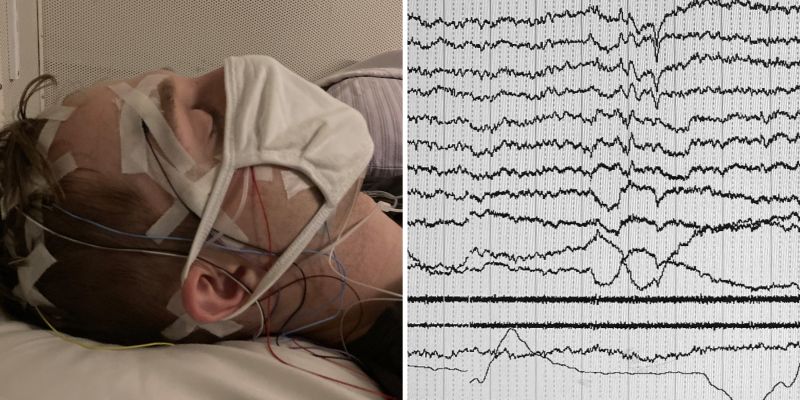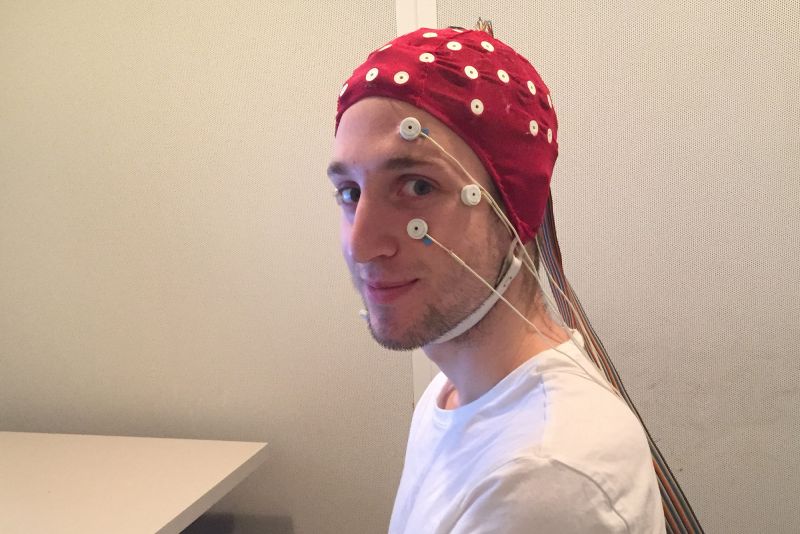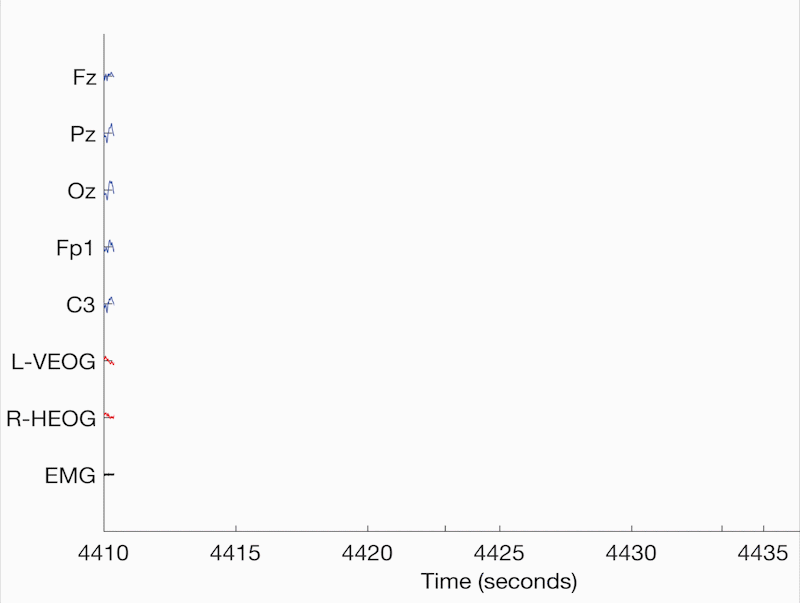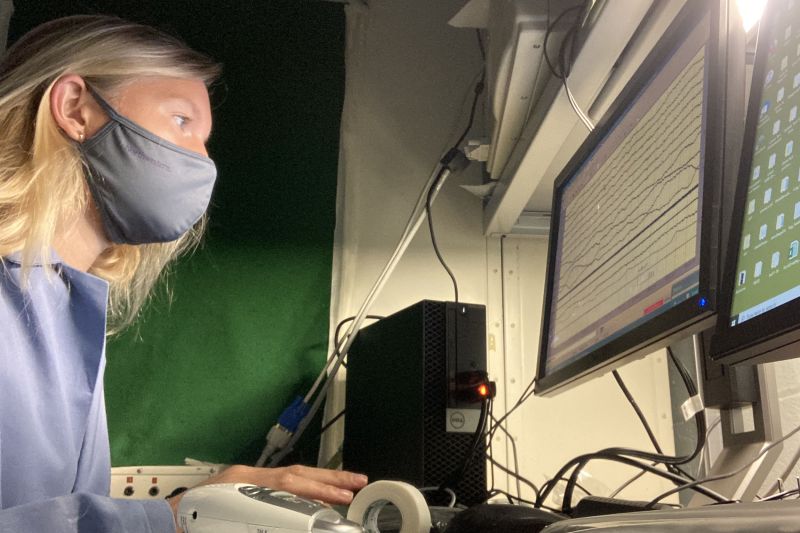
Scientists break through the wall of sleep to the untapped world of dreams
NSF-supported researchers achieve two-way communication with lucidly dreaming people, creating a new method for studying the human mind that might lead to innovative ways of learning and problem-solving.
"Eight minus six … two”
It’s not exactly “one small step for man,” but that humble mathematical message is extraordinary in its own way. The first part — “eight minus six” — was transmitted by a scientist to a place just as exotic as the moon yet frequented by each of us. The response — “two” — came from the mind of a sleeping research subject as he snoozed in a neuroscience laboratory outside Chicago.
You see, “eight minus six... two” is a dialogue between two people — one of whom was asleep and dreaming.
“It’s authentic communication,” says cognitive neuroscientist Ken Paller, who oversees the laboratory where this groundbreaking communication took place. “It can be done.”
Researchers at Paller’s lab at Northwestern University in Illinois, along with researchers in France, Germany and the Netherlands, have independently demonstrated two-way communication with people as they are lucidly dreaming during REM (rapid eye movement) sleep. Supported by the U.S. National Science Foundation, the breakthrough was achieved in the U.S. by Karen Konkoly, Paller’s doctoral student, and Christopher Mazurek, a volunteer research participant at the time of the study — and one of the first people to ever engage in a real-time dialogue from within a dream.
This discovery holds tantalizing possibilities for expanding our understanding of how our minds work. It may even lead to methods that could improve our ability to learn difficult skills or solve complex problems.
And, with the help of a new smartphone app from Paller’s lab, you could even try it at home.
The windows to the soul (and dreams)
Research into the fundamental nature of dreams, and what the human mind can do while dreaming, has been limited by a seemingly unsolvable problem: you can’t get much information about someone’s dream while they’re actually having the dream. “All we have are the stories people tell when they wake up,” says Paller. That deficiency has left an entire state of consciousness largely unexplored.
The novel methods pioneered by Konkoly, Paller and their colleagues are designed to solve this problem and open entirely new areas of research focused on the dreaming mind. Konkoly describes the possibilities: “Right now, we conduct psychology experiments with people who are awake. With two-way communication [during dreams], we could conduct some of the same experiments while people are sleeping. It could really expand our view of consciousness and what the mind is capable of.”
But, how can a dreaming research subject communicate if they can’t even move, let alone speak, while sleeping? The answer requires some explanation about what happens in our mind during sleep.
Scientists have identified the different stages of sleep by monitoring electrical signals from the brain using electroencephalography, or EEG, and from other places in the body. When the electrical signals are recorded and plotted, they chart the course our mind takes as we progress through the stages of sleep.
As you sleep, your mind transitions through several different stages, from light sleep to deep sleep and eventually to REM sleep. REM sleep is notable not just for what’s moving — our eyes — but what isn’t. Although our mind is active and dreams often occur during REM sleep, our bodies are almost completely paralyzed. That presents an obvious challenge for communications since we can’t move the body parts we typically use to communicate. As the name "rapid eye movement" suggests, however, there is an exception.
During REM sleep, our eyes move around behind our eyelids in a seemingly random fashion, which often corresponds to the sleeper “looking” at various imagined things in their dream. If you dream that you’re looking at something, your closed eyes move correspondingly as if you were looking at something while awake.
That phenomenon led researchers to a key insight: If eye movement were consciously controlled, the dreamer’s eyes could become a vehicle for getting a message to the waking world.
He’s lucid! Let’s do math
Who among us hasn’t wished we could fly like a bird? Or walk on another planet? So-called lucid dreamers can do these things and more from the comfort of their own bed. Accomplished lucid dreamers have reported being able to regularly achieve awareness in their dreams and even “programming” themselves to have dreams about specific activities or locations.
Christopher Mazurek was not one of those people.
“I had no experience with lucid dreaming,” says Mazurek, an undergraduate student at Northwestern University and now research assistant in Paller’s sleep lab. At the time, he was a volunteer research participant. “Before I entered the lab, I never had anything near a lucid dream.”
To prepare Mazurek and the other U.S. volunteers, Konkoly wired each participant with electrodes that sense brain activity through the scalp, behind the ears, on the chin and — critically — near the eyes. Those would allow the researchers to monitor and record even slight eye movements. “When your eyes move in their sockets, it creates an electrical current which is detected by the electrodes and recorded,” says Konkoly.
Konkoly also trained each research participant to help them achieve lucidity and instructed them on what to do if they succeeded. That included learning to recognize the specific sound she would play when they entered REM sleep, prompting the participants to realize they’re dreaming and thus become lucid. The participants also learned the distinct response signal they should produce from within their dream: moving their eyes from left to right multiple times.
“Repeatedly looking from left to right is a very distinctive eye movement and it stands out from other eye movements during REM sleep,” says Konkoly. As she carefully watched the EEG and saw Mazurek progressing through the stages of sleep and into REM sleep, she spotted the repeating left-right signal on the monitor as Mazurek signaled his awareness.
“He’s lucid!” remembers Konkoly. “Let’s do math.”
Konkoly played a randomly selected audio recording: "eight minus six." Mazurek knew he would be presented with simple math problems but did not know which problems would be selected. Some of the international labs in the study used different methods to send messages to their dreaming subjects, such as flashing lights in Morse code which the sleepers could perceive through their closed eyelids and manifest in their dream. In most of the labs, the research participants were trained to move their “dream eyes” to signal their answer.
A few seconds later, Konkoly saw Mazurek’s response written among the peaks and valleys of his eyes’ electrical signals: “Two.” Konkoly sent another randomly selected math problem and once again received a correct response. And what was Mazurek dreaming about during this groundbreaking exchange between two worlds?
“I dreamed I was sleeping in the lab when I heard her question,” he says. Despite that rather mundane dreamscape, “It still blew me away how different and intense and odd it all felt. It was different than anything I could have imagined.”
To obtain independent verification of their results, Konkoly sent the recorded data to an expert “sleep scorer.” Like an astrophysicist who can tell you what elements are in a distant star by deciphering the colored light recorded in a spectrograph, a sleep scorer is trained to “read” the recorded electrical signals and analyze their complex patterns. The sleep scorer confirmed that Mazurek was indeed in REM sleep during the exchange.
While Mazurek was the first in Paller’s lab to achieve two-way communication in a dream, two more participants later accomplished that same feat. Meanwhile, researchers in France, Germany and the Netherlands were independently testing methods for two-way communication in dreams and reported that three additional individuals were able to provide correct responses while dreaming. The collective results from all the laboratories are now published in the journal Current Biology.
Sleep on it
“Why would you want to do math in your sleep?” quips Konkoly. “I get that comment sometimes.”
Joking aside, researchers have a number of ideas for how this discovery could be expanded and applied. “There’s evidence that lucid dreaming is a great place to practice skills compared to when you're awake," says Konkoly. "For example, you could slow down time so you could practice a skill in more detail or practice something without having any fear of the repercussions of failing."
Imagine a surgeon attempting to perfect a technique used in open heart surgery — in a dream.
"There are many unexplored neurobiological aspects to learning and training during REM sleep. But without two-way communication, you can't conduct a proper controlled experiment to understand it," she adds.
“People say 'sleep on it,” when grappling with a hard problem," says Paller, in reference to his research published in 2019, which showed people who were cued to think about puzzles during sleep exhibited substantial improvement in finding solutions. "There's some sense that sleep can help you find an answer to a problem that's vexing you. Our two-way communication method provides hope for improving that. If you're working on a problem, can you be reminded of that problem during a dream and come up with a creative answer more easily?
"From run of the mill personal problems to complex global problems, we need creative solutions. If we can help people come up with the answers more easily, we should do that," he says.
Paller's lab has also developed a smartphone app that aims to make it easier for people to achieve lucidity, which could enable anyone to phone home from the world of dreams without visiting a sleep laboratory. You can learn how to get the app and give it a try through Paller's cognitive neuroscience website.
Our full potential
Although many aspects of the sleeping mind remain a mystery, researchers across a variety of scientific disciplines are utilizing new techniques and analytical methods to better understand it. “Sleep is valuable for our health in ways we’ve yet to come to grips with,” says Paller. For example, neuroscientists at the University of California, Berkeley, recently uncovered evidence showing that sleep plays a critical role in how our brains flush out beta-amyloid, a toxic substance that contributes to the onset of Alzheimer's disease.
“REM sleep is a unique state of consciousness,” adds Konkoly. “We spend a lot of time in it and yet no one really understands its full potential. We want to know how it works.”
The pioneering work of Konkoly, Paller and their colleagues provides an entirely new method that scientists can use to investigate how sleep and dreams affect health and mental abilities.
And who knows? Perhaps the idea of conversing with someone from within a dream may one day be as routine as sending a text message on your phone:
“Can I snooze five more minutes? I’ve almost figured out this problem...”
[Other contributors to this discovery include researchers at Osnabrück University in Germany, Sorbonne University in Paris, and Radboud University Medical Center in the Netherlands. NSF supported the researchers at Northwestern University in the U.S.]







